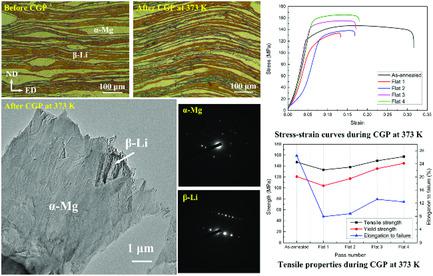当前位置:
X-MOL 学术
›
Adv. Eng. Mater.
›
论文详情
Our official English website, www.x-mol.net, welcomes your feedback! (Note: you will need to create a separate account there.)
Microstructure and Mechanical Properties of a Two‐Phase Mg–Li Alloy Processed By Constrained Groove Pressing
Advanced Engineering Materials ( IF 3.6 ) Pub Date : 2020-08-22 , DOI: 10.1002/adem.202000614 Zongshen Wang 1, 2 , Bin Zhang 1 , Wei Zhou 2 , Lihua Zhu 1 , Hongyu Zheng 1 , Yanjin Guan 3 , Wengang Zhai 2
Advanced Engineering Materials ( IF 3.6 ) Pub Date : 2020-08-22 , DOI: 10.1002/adem.202000614 Zongshen Wang 1, 2 , Bin Zhang 1 , Wei Zhou 2 , Lihua Zhu 1 , Hongyu Zheng 1 , Yanjin Guan 3 , Wengang Zhai 2
Affiliation

|
Constrained groove pressing (CGP), as a novel severe plastic deformation method, is applied to a two‐phase Mg–Li alloy at room temperature, 373 K, 423 K, and 473 K. The microstructural evolution and mechanical properties of Mg–Li alloy sheets during CGP are investigated. The optimum mechanical properties are achieved at 373 K after two passes. The tensile strength and yield strength are 157 MPa and 145 MPa, respectively, with a moderate elongation to failure of 12.4%, and the average micro‐hardness is about 63 HV. At 373 K, high‐density dislocations induced by CGP are preserved to enhance the strength and microhardness. The cross‐orientation procedure improves the deformation homogeneity and results in strength increase and ductility recovery at later stages. Increasing temperature weakens the homogeneity improvement and grain refinement with strain accumulation. The β‐Li phase is refined faster than α‐Mg phase, and grain sizes about 1 μm are observed in β‐Li phase. Dynamic recrystallization (DRX) first occurs in the soft and ductile β‐Li phase at 423 K. The grain refinement induced by DRX in β‐Li phase is counteracted by grain coarsening in α‐Mg phase, which causes no obvious enhancement of mechanical properties at higher temperatures of 423 K and 473 K.
中文翻译:

约束沟槽压制两相镁锂合金的组织和力学性能
约束沟槽压制(CGP)是一种新颖的严重塑性变形方法,适用于室温,373 K,423 K和473 K的两相Mg-Li合金。Mg-Li的组织演变和力学性能研究了CGP过程中的合金薄板。经过两次通过后,在373 K时可获得最佳的机械性能。拉伸强度和屈服强度分别为157 MPa和145 MPa,中等断裂伸长率为12.4%,平均显微硬度约为63 HV。在373 K,CGP引起的高密度位错得以保留,以增强强度和显微硬度。交叉取向过程可改善变形的均匀性,并在以后的阶段提高强度并恢复延性。温度升高会削弱均匀性,并随着应变积累而细化晶粒。β-Li相的提纯速度快于α-Mg相,在β-Li相中观察到的晶粒尺寸约为1μm。动态再结晶(DRX)首先发生在423 K的软且易延展的β-Li相中.DRX在β-Li相中诱导的晶粒细化被α-Mg相中的晶粒粗化所抵消,这不会导致机械性能的明显提高在423 K和473 K的较高温度下
更新日期:2020-08-22
中文翻译:

约束沟槽压制两相镁锂合金的组织和力学性能
约束沟槽压制(CGP)是一种新颖的严重塑性变形方法,适用于室温,373 K,423 K和473 K的两相Mg-Li合金。Mg-Li的组织演变和力学性能研究了CGP过程中的合金薄板。经过两次通过后,在373 K时可获得最佳的机械性能。拉伸强度和屈服强度分别为157 MPa和145 MPa,中等断裂伸长率为12.4%,平均显微硬度约为63 HV。在373 K,CGP引起的高密度位错得以保留,以增强强度和显微硬度。交叉取向过程可改善变形的均匀性,并在以后的阶段提高强度并恢复延性。温度升高会削弱均匀性,并随着应变积累而细化晶粒。β-Li相的提纯速度快于α-Mg相,在β-Li相中观察到的晶粒尺寸约为1μm。动态再结晶(DRX)首先发生在423 K的软且易延展的β-Li相中.DRX在β-Li相中诱导的晶粒细化被α-Mg相中的晶粒粗化所抵消,这不会导致机械性能的明显提高在423 K和473 K的较高温度下



























 京公网安备 11010802027423号
京公网安备 11010802027423号